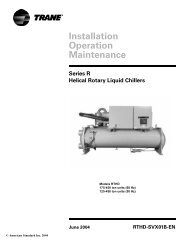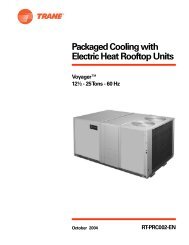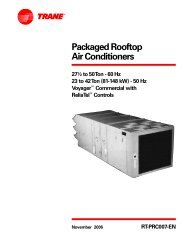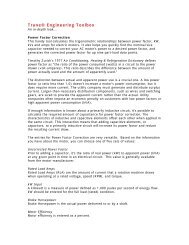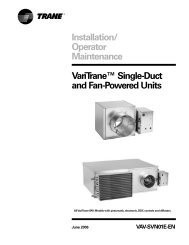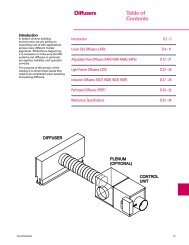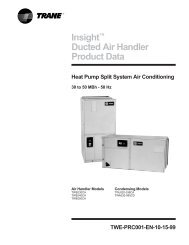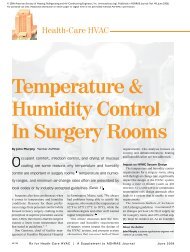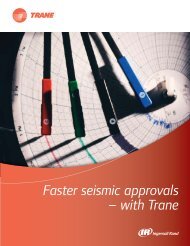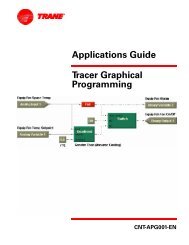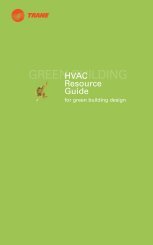12½ - 20 Tons - Trane
12½ - 20 Tons - Trane
12½ - 20 Tons - Trane
You also want an ePaper? Increase the reach of your titles
YUMPU automatically turns print PDFs into web optimized ePapers that Google loves.
Selection<br />
Procedure<br />
Example:<br />
Cooling Capacity<br />
Step 1<br />
Calculate the building’s total and sensible<br />
cooling loads at design conditions. Use<br />
the American Standard calculation form<br />
or any other standard accepted method.<br />
Step 2<br />
Given the following building<br />
requirements:<br />
A<br />
Electrical Characteristics: 460/60/3<br />
B<br />
Summer Design Conditions:<br />
Entering Evaporator Coil: 80 DB/ 67 WB<br />
Outdoor Ambient: 95 DB<br />
C<br />
Total Cooling Load: 172 MBh<br />
D<br />
Sensible Cooling Load: 122 MBh<br />
E<br />
Airflow: 6000 cfm<br />
F<br />
External Static Pressure: .50 in. w.g.<br />
G<br />
Rooftop - downflow configuration.<br />
H<br />
Accessories<br />
Economizer<br />
Supplementary Electric Heat<br />
I<br />
Heating Capacity 88 MBh<br />
460 volt/3 phase Electric Supplemental<br />
Heat - at 6000 cfm<br />
Size the equipment using Table PD-3.<br />
As a starting point, a rough determination<br />
of the size of the unit must be made. This<br />
selection will then be confirmed after<br />
examining the performance at the given<br />
conditions. Divide the total cooling load by<br />
nominal BTUH per ton (12 MBh per ton);<br />
then round up to the nearest unit size.<br />
172 MBh/12 MBh = 14.33 (approx. 15<br />
tons.)<br />
Step 3<br />
Table PD-3 shows that a WCD180B4 has<br />
a gross cooling capacity of 183.0 MBh<br />
and 129.0 MBh sensible capacity at 95<br />
degree ambient and 6000 cfm with 80<br />
DB/67 WB air entering the evaporator.<br />
To Find Capacity at Intermiediate<br />
Conditions<br />
When the design conditions are between<br />
two numbers that are in the capacity<br />
table, interpolation is required to<br />
approximate the capacity.<br />
Note: Extrapolation outside of the table<br />
conditions is not recommended.<br />
Step 4<br />
Verify that there will be enough capacity<br />
by determining net capacity. In order to<br />
select the correct unit which meets the<br />
building’s requirements, the fan motor<br />
heat must be deducted from the gross<br />
cooling capacity. The amount of heat that<br />
the fan motor generates is dependent on<br />
the effort by the motor cfm and static<br />
pressure. To determine the total unit static<br />
pressure, add the following:<br />
External Static: 0.50 in.<br />
Standard Filter 1 in: 0.11 in. (from table<br />
PD-12)<br />
Economizer Return Air: 0.04 in. (from<br />
table PD-12)<br />
Electric Heater Size 18 kW: .06 in.<br />
Total Static Pressure: .71 in.<br />
Note: The Evaporator Fan Performance<br />
Table PD-7 has already accounted for the<br />
pressure drop for standard filters and wet<br />
coils.<br />
Therefore, the actual Total Static<br />
Pressure is .71 - .11 = .60.<br />
With 6000 cfm and .60 inches, Table PD-7<br />
shows 2.66 Bhp.<br />
The note below Table PD-7 gives a<br />
formula to calculate Fan Motor Heat:<br />
3.15 x bhp = MBh<br />
3.15 x 2.66 = 8.38 MBh<br />
Now subtracting the fan motor heat from<br />
the gross cooling capacity of the unit:<br />
Net Total Cooling Capacity =<br />
183-8.38=170.62<br />
Net Sensible Cooling Capacity=<br />
129-8.38=1<strong>20</strong>.62<br />
Step 5<br />
If the performance will not meet the<br />
required load of the building, try a<br />
selection at the next higher size unit.<br />
Heating Capacity<br />
Step 1<br />
Calculate the building heating load using<br />
the American Standard calculation form<br />
or other standard accepted method.<br />
Step 2<br />
Size the equipment using Table PD-15 to<br />
match the heating loads at design<br />
conditions.<br />
A<br />
Total Heating Load: 88 MBh<br />
B<br />
Outdoor Ambient (Winter) 17 DB<br />
C<br />
Indoor Return Temperature: 70 DB<br />
D<br />
Airflow: 6000 Cfm<br />
Use the integrated portion of Table<br />
PD-15 for the WCD180B4 to determine<br />
capacity at winter design conditions. The<br />
mechanical heating portion of the heat<br />
pump will provide 45 MBh.<br />
Step 3<br />
Because 45 MBh is less than the<br />
building’s required heating capacity at<br />
winter design conditions, a<br />
supplementary heater must be selected.<br />
88 MBh - 45 MBh = 43 MBh<br />
From Table PD-19, at 480 volts, the 18 kW<br />
Heater will be adequate to do the job.<br />
18 kW 61 MBh<br />
From Table ED-3 select heater<br />
AYDHTRK418A (18 kW 460/60/3).<br />
PKGP-PRC001-EN 9



